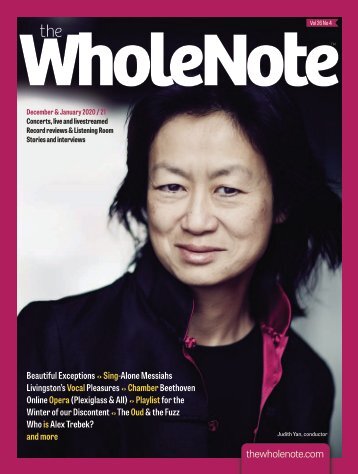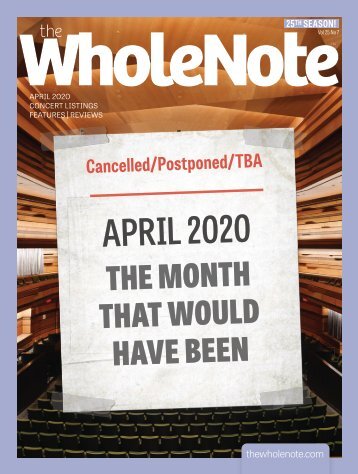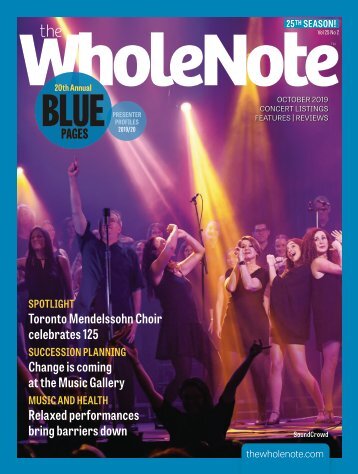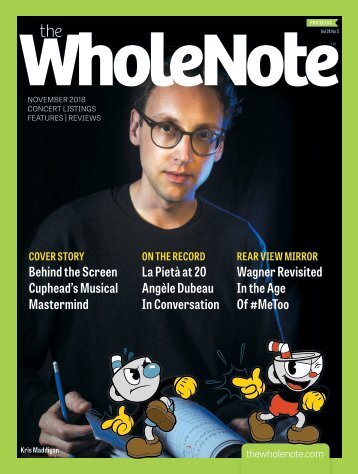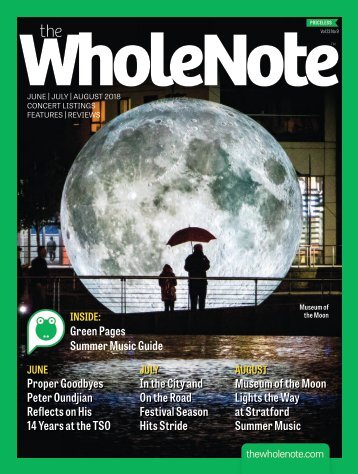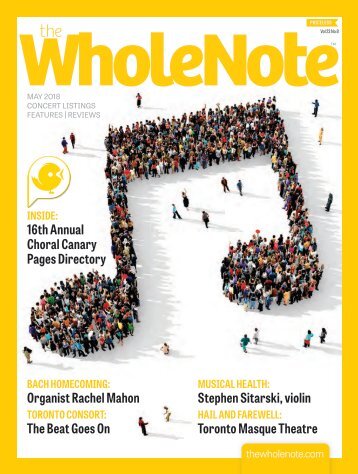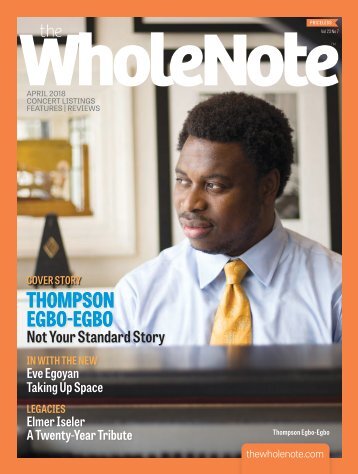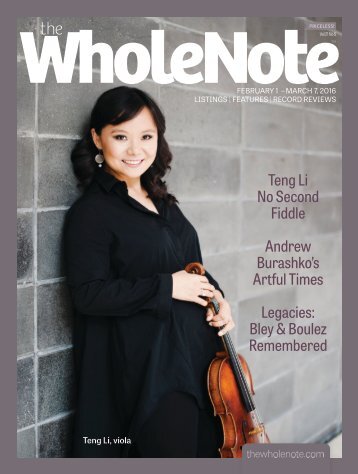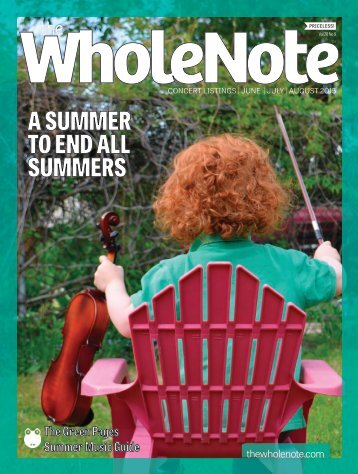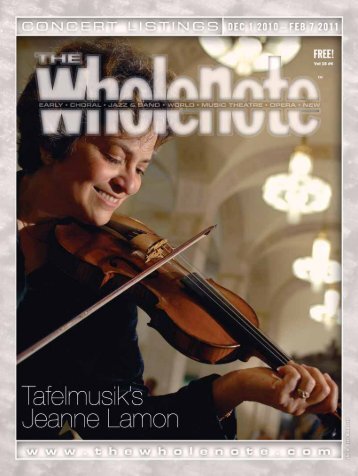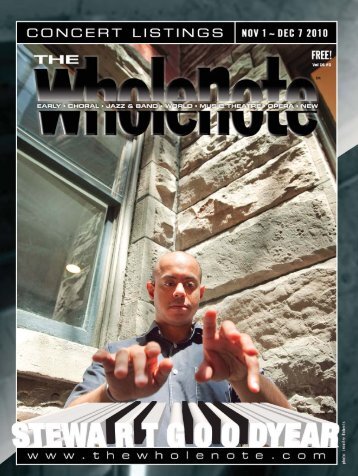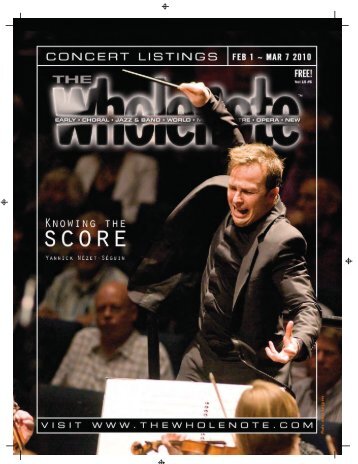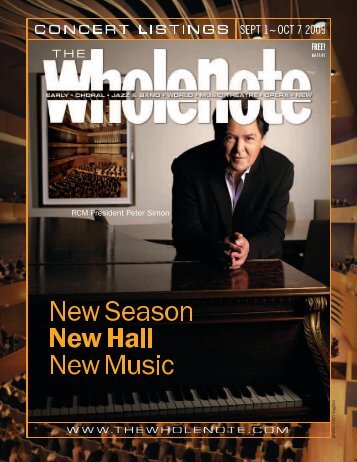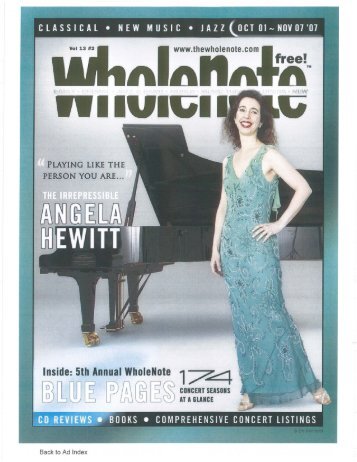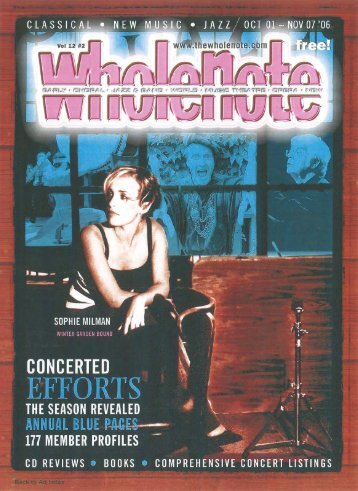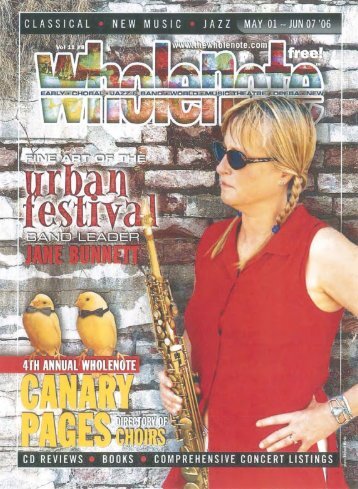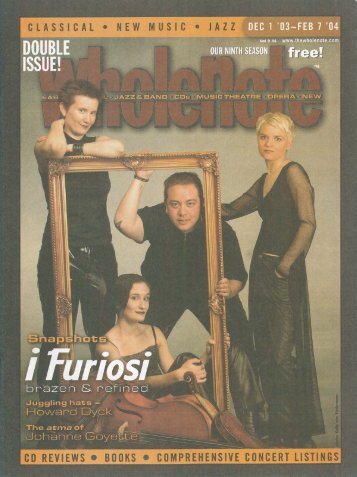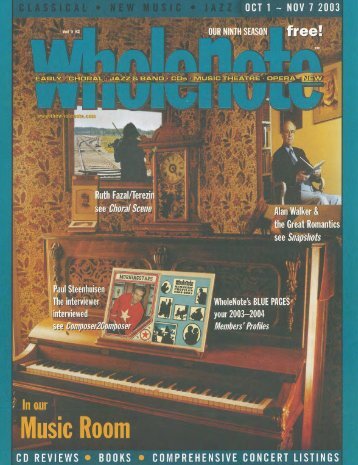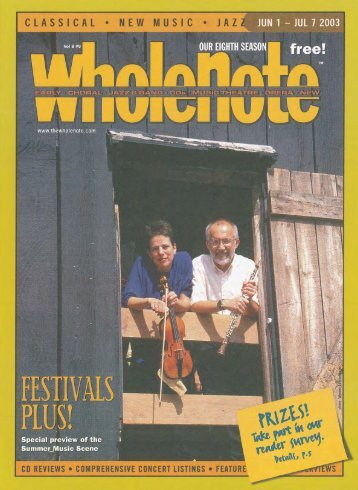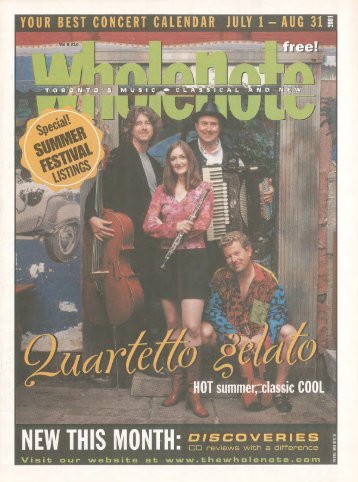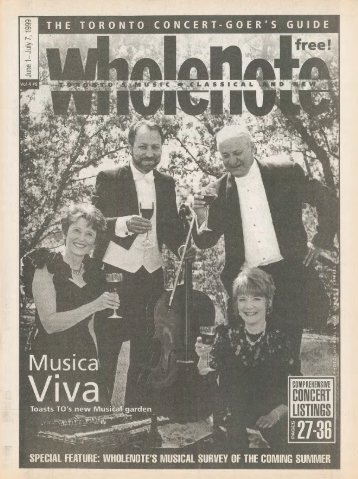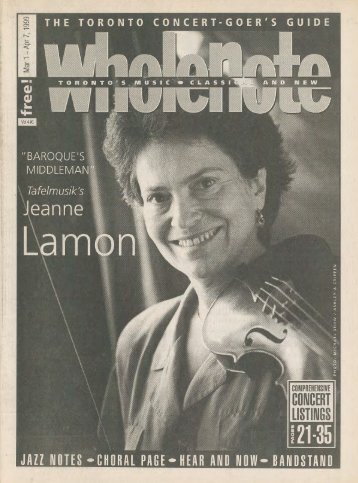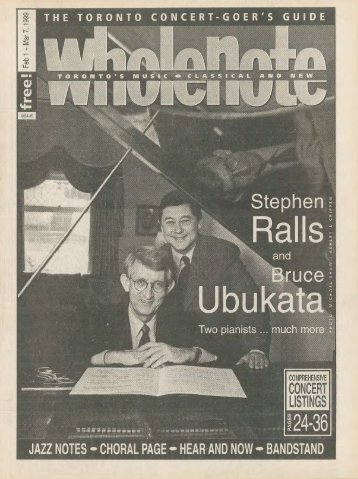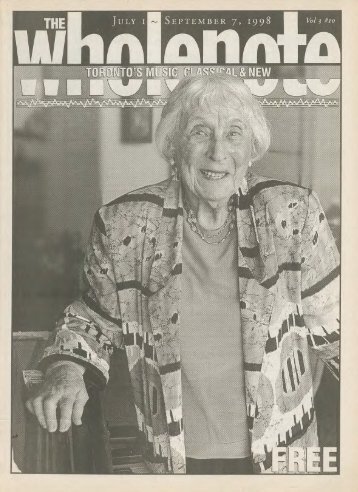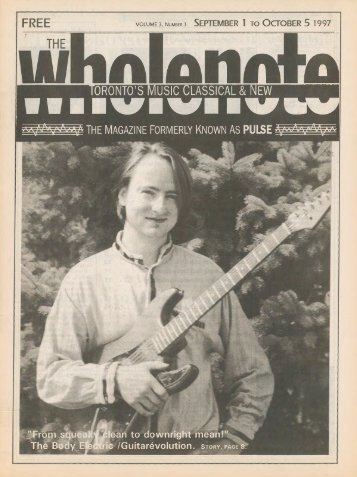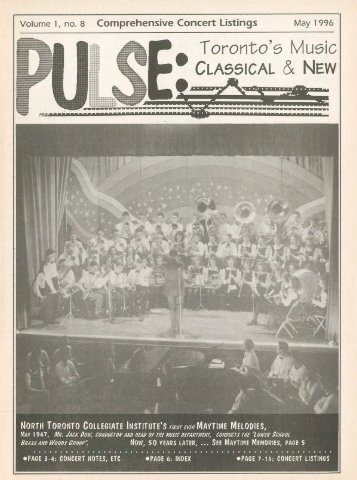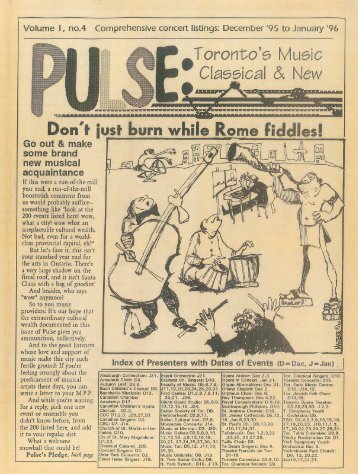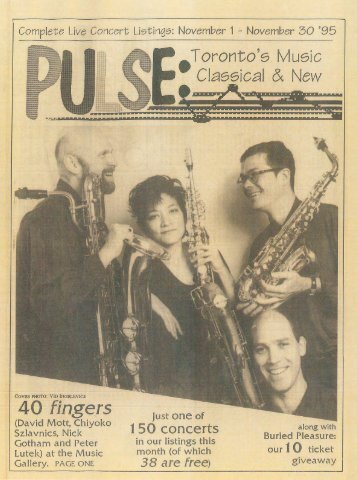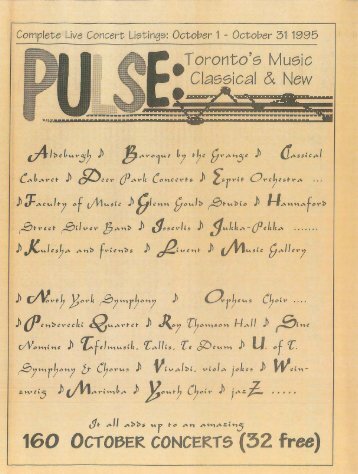Volume 18 Issue 4 - December 2012
- Text
- Toronto
- December
- Theatre
- Jazz
- January
- February
- Arts
- Symphony
- Choir
- Concerts
Berio’s SequenzaBack
Berio’s SequenzaBack to BackLuciano Berio (1925–2003) is oneof the great icons of New Music.Among the Italian composer’stowering works is Sequenza, a seriesof solos he wrote for individualinstruments and voice. The sequenzeare a throughline in Berio’s longand distinguished career. SequenzaI for flute was written in 1958,while Sequenza XIV for cello wascompleted in 2002, a year beforethe composer’s death. Each soloexplores the fullest possibilities ofthe individual instrument.On Jan 21, 2013 at Walter Hall, the entire Sequenzawill be p resented, all 3 hours and 40 minutes of it, aspart of the University of Toronto’s New Music Festival.The concert also includes the poetry written by EdoardoSanguineti that precedes each solo. This is the first timethat the complete Sequenza will be presented in Canada,and the concert features an outstanding group of soloists.(Please see page 11.)The artistic directors for the Berio Sequenza Project arecellist David Hetherington and accordionist Joseph Petric.Hetherington is the Toronto Symphony Orchestra’s assistantprincipal cellist and a well-known solo performer.Petric tours the world as a much-in-demand classicalaccordionist. (Both men will also be performing theirinstruments’ sequenze.)The WholeNote had a lively, early morning, three-waytelephone conversation with Hetherington and Petricabout Berio, his sequenze, and the upcoming concert.How did you two meet?Petric: It was at a Soundstreams Canada concert in 2008.Lawrence Cherney brought us together to perform SofiaGubaidulina’s The Seven Words for cello, accordion andstring orchestra.Hetherington: After that we formed the chamber groupDuo ConTempera where we play works written for celloand accordion, as well as individual solos.When did you first become acquainted withthe sequenza for your own instrument?Petric: When I started my career, classical accordionwas new in the concert world and I was always lookingfor pieces to program. It was an important event for theinstrument when Berio wrote Sequenza XIII for accordionin 1995.Hetherington: In 2007, I was part of a New Music Concertsperformance with Sri Lankan cellist Rohan de Saram. Heperformed solos and I was there to play duo cello pieceswith him. One of his solos was Sequenza XIV which BerioAn interview by Paula CitronHetherington and Petric.had written for him. It incorporated elements of Sri Lankanmusic, like drumming on the top of the cello. It wassuch a fantastic piece and so approachable, that I wantedto do it.What led to the Toronto Sequenza?Petric: I was invited to play the accordion sequenza in2000 at Tanglewood. The festival was mounting thecomplete Sequenza in honour of Berio’s 75th birthday.That performance triggered my motivation to mount aSequenza in Canada. It was always at the back of my mind.After all, Toronto is a hub of new music.Hetherington: When Joseph suggested it, I thought it wasa great idea. Originally, we planned it for Bob Aitken’sNew Music Concerts, but he couldn’t fit it into his series.We then approached Norbert Palej, artistic directorof the U of T New Music Festival, and he snapped it upas a celebration of the 10th anniversary of Berio’s death.Petric: Between David and me, we had two of thesequenze. We just had to find 12 other musicians.There are really 15 solos on your program,one more than the original 14 sequenze.Petric: That’s right. We’ve also included Sequenza VIIb,which is the soprano saxophone adaptation of SequenzaVII for oboe. We felt it should be there because it was sucha favourite of Berio’s.Hetherington: In fact, many of the sequenze have beenarranged and adapted for other instruments. Berio waskeen to get his music out there. For example, Sequenza IXfor clarinet has two adaptions, IXb is for alto saxophoneand IXc is for bass clarinet. The cello sequenza has a XIVbfor double bass.I understand that there is some staging involved.Petric: Our original idea was to have Graham Cozzubbodo the stage direction. He had staged the TanglewoodSequenza, and he’s a Canadian director who lives herein Toronto. But when he looked at Walter Hall, he felt thatbecause the venue is so small and the theatrical resourcesso limited, a full-blown staging wasn’t possible.Rather, he’s calling his work for us “creative animationfor the concert stage.” We’ll still be exploring spaceand breaking visual lines to enliven the narration andmusical presentation.Hetherington: Most of the audience isn’t familiar withthe work, so we didn’t just want to trot out 15 musiciansAIR’LETH aodHFIN8 thewholenote.com December 1 – February 7, 2013
one after the other, all doing the same routine. It’s betterthat the various solos be differentiated in some way toenhance emotional impact. We want to draw the audiencein — to give them a sense of a theatrical event. To make itmore than just a concert.You mention narration. Berio frequently fused thespoken word and music together in his compositions.Petric: That’s right. Berio had a great empathy for the literarycomponent, and was always looking for texts hecould incorporate with his music. In the 1960s, he workedclosely with Umberto Eco, then a producer for the Milanstation of RDI Italian radio. Eco, you might remember,wrote the novel The Name of the Rose. Both men werealso involved with Gruppo 64 and Studio di Fonologio,both hubs of electronic music in Milan.Tell me about the Sequenza poetry.Petric: Edoardo Sanquineti was an Italian poet and a verygood friend of Berio. In 1994, he wrote verses to go withthe sequenze. In terms of presentation, they precede eachsolo. The poetry helps create a sense of an event. The wordsprovide layers and moods to the music. We’re using theEnglish translations by Stewart Spencer in the liner notesfor the Deutsche Grammophon recording.Hetherington: The inclusion of the poetry just showsyou how open Berio was to broadening the horizons ofNew Music.I’d love to hear samples of the poetry.What about the verses for your own instruments?Petric: Our instruments are the last two sequenze. Here’sthe one for the accordion, Sequenza XIII. Berio subtitledit Chanson.“… and so a chord consoles us, gently enclosing us, commonly;the catastrophe is within, in our hearts; but itremains confined, entrenched.”And for the cello, Sequenza XIV.“… Oh! Oh! What celebrations! And what laments tofollow! And what dances! And what sweet sorrows! Andwhat accidents! And rush, and rendings, and burstings!What parings, guttings, lashings! And then a dying fall …”They’re quite evocative. What about a couple ofretro ones that Sanguineti would have writtenlong after the sequenze were composed?Petric: Here are the first two. Sequenza I for flute.“…and here begins our desire, which is the delirium ofmy desire. Music is the desire of desires.”And for Sequenza II for harp.“I have heard chains of colours, muscularly aggressive.I have felt your rough and rigid noises.”Can you give me an idea of how Cozzubboanimated the music at Tanglewood?Petric: He put me up on a riser with a beautiful younglady listening at my feet. When I finished with a page ofmusic, she reached up and took it off the stand.All my research talks of “extended technique”in connection with Sequenza. Just howdifficult are the solos to play?Hetherington: The cello solo is not all that adventurousin the playing technique. What’s important is how themusic sounds. I mentioned before about the drumming. Toplay it, cellists need a notation we can understand, so thescore has two staffs, one for the cello line, and one belowwith the percussive effects. You have to do both simultaneously— play the notes with the left hand and drum onthe fingerboard with the right. There are other technicalelements involved like glissandi and tapping with the bow.Petric: I’ve played a lot more demanding pieces than theaccordion sequenza, but the key here is Berio’s harmoniclanguage which is entirely his own. He notated everything.You have to train your fingers to get around his gnarlynotes, his beautiful moments of catastrophe.December 1 – February 7, 2013 thewholenote.com 9
- Page 1 and 2: Vol 18 No 4DOUBLE ISSUE!Concert Lis
- Page 5 and 6: Volume 18 No 4 | December 1 - Febru
- Page 7: Holiday2012The Barra MacNeilsGo Tel
- Page 11 and 12: are regularly performed. Certain wo
- Page 13 and 14: KOERNER HALL IS:“A beautiful spac
- Page 15 and 16: 2013 Great Artist Piano SeriesPrese
- Page 17 and 18: Conservatory (in association with A
- Page 19 and 20: Jennifer BauerBeat by Beat | Choral
- Page 21 and 22: 2013 concerts to watch for: Conduct
- Page 23 and 24: Beat by Beat | World ViewHistoryRe-
- Page 25 and 26: Robert Aitken, artistic directorSun
- Page 27 and 28: Beat by Beat | Art of SongThree Fac
- Page 29 and 30: Beat by Beat | Early MusicMeet the
- Page 31 and 32: Beat by Beat | On OperaThree to Sav
- Page 33 and 34: orator (Jesus Christ Superstar, Evi
- Page 35 and 36: Beat by Beat | Jazz NotesIn One Yea
- Page 37 and 38: Beat by Beat | BandstandRing in the
- Page 39 and 40: A Rainbow’sWorth ofMusical Promis
- Page 41 and 42: Sweet with Starlight: Classical, Ch
- Page 43 and 44: • 1:00: Cathedral Church of St. J
- Page 45 and 46: North Brass; Eleanor Daley and Shaw
- Page 47 and 48: • 4:00: Cathedral Church of St. J
- Page 49 and 50: • 8:00: Georgetown Bach Chorale.
- Page 51 and 52: Concert. See 3:00.• 7:30: Theatre
- Page 53 and 54: sing-along. 171 Town Centre Blvd.,
- Page 55 and 56: Friday January 04• 6:45: Toronto
- Page 57 and 58: singers in the classical voice perf
- Page 59 and 60:
Ubukata, piano. Walter Hall, Edward
- Page 61 and 62:
Monday February 04• 7:00: Univers
- Page 63 and 64:
Celtic Christmas Concert. Aeolian H
- Page 65 and 66:
Dovercourt House805 Dovercourt Rd.
- Page 67 and 68:
31 8pm New Year’s Eve Bash w/ Gro
- Page 69 and 70:
416-924-6211 x0. 0.• Feb 01 Ea
- Page 71 and 72:
CONTEST! MUSIC’S CHILDREN IN 2012
- Page 73 and 74:
DISCOVERIES | RECORDINGS REVIEWEDDA
- Page 75 and 76:
Wagner - Der Ring Des Nibelungen;Wa
- Page 77 and 78:
Lussier for bringing these delightf
- Page 79 and 80:
ous vocalist SophiaPerlman and gift
- Page 81 and 82:
Kate Hammett-Vaughan can be Canada
- Page 84 and 85:
Peterborough Singers.balthazar denn
- Page 86 and 87:
THE POWER180 MUSICIANS ON STAGE. FI
- Page 88:
PAULA CITRON, CLASSICAL 96.3NEW YEA
Inappropriate
Loading...
Mail this publication
Loading...
Embed
Loading...
























